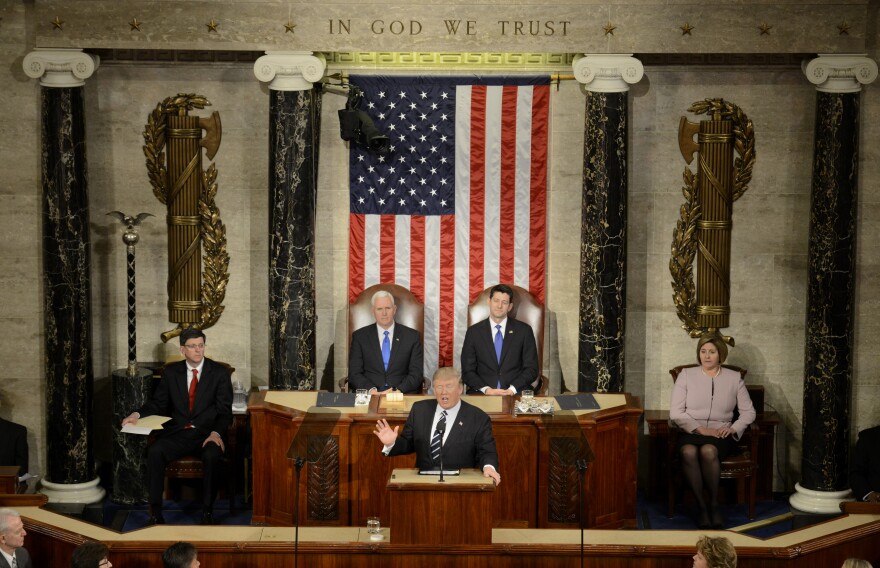With our free press under threat and federal funding for public media gone, your support matters more than ever. Help keep the LAist newsroom strong, become a monthly member or increase your support today.
5 questions: How a merit-based immigration system would work

In his speech to Congress on Tuesday , President Trump proposed the United States adopt a "merit-based" immigration system, similar to that used in countries like Canada and Australia.
If Trump's idea is adopted, it would mark a significant shift in the long-standing U.S. immigration policy that has stressed family unification to one favoring entrants who can support themselves and contribute to the economy.
"The current, outdated system depresses wages for our poorest workers and puts great pressure on taxpayers," Trump told congressional members.
"It is a basic principle that those seeking to enter a country ought to be able to support themselves financially. Yet, in America, we do not enforce this rule, straining the very public resources that our poorest citizens rely upon," he said.
The president's proposal comes on the heels of his executive orders that would suspend entry of refugees, temporarily bar immigrants from seven Muslim-majority countries and prioritize for deportation those unauthorized immigrants who have broken the law, regardless of the seriousness of their crimes.
Changing the county's long-established framework for legal immigration would not be a quick or easy move, if it comes to pass at all, and it would require action from Congress. Here's more on what a merit-based immigration system is, and what it could look like in the U.S.
Q: What is a merit-based immigration system?
In a merit-based system, points are awarded to aspiring immigrants for various skills and other factors. For example, in Canada, points are awarded for higher education; those with the most advanced degrees earn more points. Points are also awarded for language, employment experience, and other considerations. While family ties in Canada will score some points, these aren't given priority.
Louis DeSipio, a political scientist who teaches immigration policy at University of California, Irvine, explains it this way:
"[A merit-based system] increases the odds that you would be able to immigrate if you had an advanced degree, or if you had a specific job skill, or if you have English language skills."
However, he adds, "it would reduce the value of having an immediate relative in the United States."
Q: How does a merit-based system differ from the legal immigration system in the U.S.?
Our immigration system is primarily family-based, with the emphasis on uniting those here with their wives and husbands, children, parents, siblings and other relatives.
In the last decade, between 60 and 70 percent of immigrant visas have gone to family members of primarily U.S. citizens and, to a lesser degree, legal residents. These immigrants are sponsored by their U.S. relatives.
Each year, every nation is allotted the same percentage of visas available from a pool of family and employer-based immigrant visas. For countries with a high demand for family reunification, the wait for an immigrant visa can be very long . For example, waits for legal immigrants from Mexico, the Philippines, China and India can take many years. Waits for siblings from Mexico and the Philippines, in particular, can take 20 years or more.
Immediate relatives of U.S. citizens, defined as spouses, parents, and children under 21, are exempt from the limits.
Q: Why did the family-based immigration system in the U.S. come about?
The current system dates back to the the Immigration and Naturalization Act of 1965, when immigration laws were changed to stop favoring European immigrants and accept more immigrants from Asia, Latin America and other parts of the world.
The policies were also redrawn to replace the then existing system with a family-preference one; it relied on quotas as well as employer-based immigrant visas.
Supporters of the family-based system say that reuniting immigrant families makes for strong support networks , allowing family members to more easily work, raise children, and start businesses.
But critics complain of "chain migration" that drives up the number of immigrants in the United States. They also argue that the long waits for reunification help fuel unauthorized migration.
Q: Would merit-based immigration result in a shift in the countries that would be favored in granting admissions?
Experts say that a focus on advanced degrees could favor high-skilled workers from Asia. Such workers now largely enter the U.S. under the H-1B visa and many are hired by the tech industry.
While there are high-skilled workers hired from Latin America as well, a merit-based immigration could result in fewer lower-skilled immigrants from the region. Lower-skilled immigrants from Mexico and Central America who would typically take jobs in industries like construction and hospitality, for example, would find less favor in gaining entry.
This could weed out entrepreneurs, said Moises Cisneros executive director of the Los Angeles Latino Chamber of Commerce. Cisneros said small business owners from Latin America who come to the U.S. and start a business contribute to the local and national economy.
“If we exclude the risk-takers, the individuals who work really hard under harsh circumstances, that is when we get into an issue of a decline in our economy," Cisneros said.
Q: Will a merit-based immigration system help end illegal immigration?
The simple answer is no, said DeSipio. The jobs magnet that is the U.S. remains strong and unauthorized immigrants fill in those other parts of the economy that need them.
Canada has a robust refugee policy, and refugees often take lower-skilled jobs. But the president did not mention them in proposing a merit-based immigration system.







